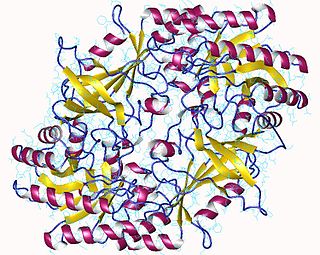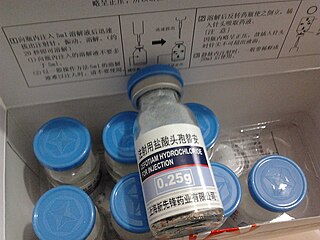Related Research Articles
Involuntary commitment, civil commitment, or involuntary hospitalization/hospitalisation is a legal process through which an individual who is deemed by a qualified person to have symptoms of severe mental disorder is detained in a psychiatric hospital (inpatient) where they can be treated involuntarily. This treatment may involve the administration of psychoactive drugs, including involuntary administration. In many jurisdictions, people diagnosed with mental health disorders can also be forced to undergo treatment while in the community; this is sometimes referred to as outpatient commitment and shares legal processes with commitment.
Biological determinism, also known as genetic determinism, is the belief that human behaviour is directly controlled by an individual's genes or some component of their physiology, generally at the expense of the role of the environment, whether in embryonic development or in learning. Genetic reductionism is a similar concept, but it is distinct from genetic determinism in that the former refers to the level of understanding, while the latter refers to the supposed causal role of genes. Biological determinism has been associated with movements in science and society including eugenics, scientific racism, and the debates around the heritability of IQ, the basis of sexual orientation, and evolutionary foundations of cooperation in sociobiology.

Tryptophan (symbol Trp or W) is an α-amino acid that is used in the biosynthesis of proteins. Tryptophan contains an α-amino group, an α-carboxylic acid group, and a side chain indole, making it a polar molecule with a non-polar aromatic beta carbon substituent. Tryptophan is also a precursor to the neurotransmitter serotonin, the hormone melatonin, and vitamin B3. It is encoded by the codon UGG.
Ferrocene is an organometallic compound with the formula Fe(C5H5)2. The molecule is a complex consisting of two cyclopentadienyl rings sandwiching a central iron atom. It is an orange solid with a camphor-like odor that sublimes above room temperature, and is soluble in most organic solvents. It is remarkable for its stability: it is unaffected by air, water, strong bases, and can be heated to 400 °C without decomposition. In oxidizing conditions it can reversibly react with strong acids to form the ferrocenium cation Fe(C5H5)+2. Ferrocene and the ferrocenium cation are sometimes abbreviated as Fc and Fc+ respectively.

Heme, or haem, is a ring-shaped iron-containing molecular component of hemoglobin, which is necessary to bind oxygen in the bloodstream. It is composed of four pyrrole rings with 2 vinyl and 2 propionic acid side chains. Heme is biosynthesized in both the bone marrow and the liver.

The enzyme ornithine decarboxylase catalyzes the decarboxylation of ornithine to form putrescine. This reaction is the committed step in polyamine synthesis. In humans, this protein has 461 amino acids and forms a homodimer.

α-Amanitin (alpha-Amanitin) is a cyclic peptide of eight amino acids. It is possibly the most deadly of all the amatoxins, toxins found in several species of the mushroom genus Amanita, one being the death cap as well as the destroying angel, a complex of similar species, principally A. virosa and A. bisporigera. It is also found in the mushrooms Galerina marginata, Lepiota subincarnata and Conocybe filaris. The oral LD50 of amanitin is 100 μg/kg for rats.

A monoclonal antibody is an antibody produced from a cell lineage made by cloning a unique white blood cell. All subsequent antibodies derived this way trace back to a unique parent cell.

The Rosenhan experiment or Thud experiment was an experiment regarding the validity of psychiatric diagnosis. In the experiment, participants submitted themselves for evaluation at various psychiatric institutions and feigned hallucinations in order to be accepted, but acted normally from then onward. Each was diagnosed with psychiatric disorders and were given antipsychotic medication. The study was arranged by psychologist David Rosenhan, a Stanford University professor, and published by the journal Science in 1973 under the title "On Being Sane in Insane Places".

Hydroxycarbamide, also known as hydroxyurea, is a medication used in sickle-cell disease, essential thrombocythemia, chronic myelogenous leukemia, polycythemia vera, and cervical cancer. In sickle-cell disease it increases fetal hemoglobin and decreases the number of attacks. It is taken by mouth.
David L. Rosenhan was an American psychologist. He is best known for the Rosenhan experiment, a study challenging the validity of psychiatry diagnoses.

DNA polymerase II is a prokaryotic DNA-dependent DNA polymerase encoded by the PolB gene.

Macromerine is a phenethylamine derivative. It was first identified from the cactus Coryphantha macromeris. It can also be found in C. runyonii, C. elephantidens, and other related members of the family Cactaceae.

Sodium phenylbutyrate, sold under the brand name Buphenyl among others, is a salt of an aromatic fatty acid, 4-phenylbutyrate (4-PBA) or 4-phenylbutyric acid. The compound is used to treat urea cycle disorders, because its metabolites offer an alternative pathway to the urea cycle to allow excretion of excess nitrogen.

Proliferating cell nuclear antigen (PCNA) is a DNA clamp that acts as a processivity factor for DNA polymerase δ in eukaryotic cells and is essential for replication. PCNA is a homotrimer and achieves its processivity by encircling the DNA, where it acts as a scaffold to recruit proteins involved in DNA replication, DNA repair, chromatin remodeling and epigenetics.

Cefotiam is a parenteral third-generation cephalosporin antibiotic. It has broad-spectrum activity against Gram-positive and Gram-negative bacteria. As a beta-lactam, its bactericidal activity results from the inhibition of cell wall synthesis via affinity for penicillin-binding proteins.

Deoxyadenosine triphosphate (dATP) is a nucleotide used in cells for DNA synthesis, as a substrate of DNA polymerase.

Ralph Marvin Steinman was a Canadian physician and medical researcher at Rockefeller University, who in 1973 discovered and named dendritic cells while working as a postdoctoral fellow in the laboratory of Zanvil A. Cohn, also at Rockefeller University. Steinman was one of the recipients of the 2011 Nobel Prize in Physiology or Medicine.

Pre-B-cell leukemia transcription factor 1 is a protein that in humans is encoded by the PBX1 gene. The homologous protein in Drosophila is known as extradenticle, and causes changes in embryonic development.
Jerrold Schwaber was an American biologist and geneticist. In 1973 he described, with Edward Cohen, a method of producing antibodies involving human–mouse hybrid cells, or hybridomas. They fused "mouse myeloma cells secreting immunoglobulin of known specificity and human peripheral blood lymphocytes not secreting detectable immunoglobulin. The hybrid cells continued secretion of mouse immunoglobulin and initiate synthesis and secretion of human immunoglobulin." The antibody producing cells did not survive long and the antigens that the antibodies targeted remained unknown. In 1975, Georges Köhler, César Milstein, and Niels Kaj Jerne, succeeded in making hybridomas that made antibodies to known antigens and that were immortalized. They shared the Nobel Prize in Physiology or Medicine in 1984 for the discovery. His work in laying the foundation for modern monoclonal antibody technology is recognized.
References
- ↑ Woodward, R. B. (1973). "The Total Synthesis of Vitamin B12". Pure and Applied Chemistry . 33 (1): 145–178. doi: 10.1351/pac197333010145 . PMID 4684454. S2CID 30641959 . Retrieved 2012-01-13.
- ↑ Nicolaou, K. C.; Sorensen, E. J. (1996). Classics in Total Synthesis: Targets, Strategies, Methods. Wiley. ISBN 978-3-527-29231-8.
- ↑ Endo, Akira; Kuroda M.; Tsujita Y. (December 1976). "ML-236A, ML-236B, and ML-236C, new inhibitors of cholesterogenesis produced by Penicillium citrinium". Journal of Antibiotics. 29 (12): 1346–8. doi: 10.7164/antibiotics.29.1346 . PMID 1010803.
- ↑ Peter Weiner (October 1973). "Linear pattern matching algorithms". Symposium on Foundations of Computer Science : 1–11. CiteSeerX 10.1.1.474.9582 . doi:10.1109/SWAT.1973.13. Wikidata Q29541479.
- ↑ Disclosed 1997. https://web.archive.org/web/20100519084635/http://www.gchq.gov.uk/history/pke.html
- ↑ Black, Fischer; Scholes, Myron (May–June 1973). "The Pricing of Options and Corporate Liabilities". Journal of Political Economy . 81 (3). University of Chicago Press: 637–654. doi:10.1086/260062. JSTOR 1831029. S2CID 154552078.
- ↑ Stückrad, Jürgen; Vogel, Wolfgang (1973). "Eine Verallgemeinerung der Cohen-Macaulay Ringe und Anwendungen auf ein Problem der Multiplizitätstheorie". Journal of Mathematics of Kyoto University. 13: 513–528. ISSN 0023-608X. MR 0335504.
- ↑ Stückrad, Jürgen; Vogel, Wolfgang (1986). Buchsbaum rings and applications. Berlin; New York: Springer-Verlag. ISBN 978-3-540-16844-7. MR 0881220.
- ↑ Schwaber, J.; Cohen, E. P. (1973). "Human x mouse somatic cell hybrid clone secreting immunoglobulins of both parental types". Nature . 244 (5416): 444–7. doi:10.1038/244444a0. PMID 4200460. S2CID 4171375.
- ↑ Steinman, R. M.; Cohn, Z. A. (1973). "Identification of a Novel Cell Type in Peripheral Lymphoid Organs of Mice: I. Morphology, Quantitation, Tissue Distribution". Journal of Experimental Medicine. 137 (5): 1142–62. doi:10.1084/jem.137.5.1142. PMC 2139237 . PMID 4573839.
- ↑ Rosenhan, D. L. (January 1973). "On being sane in insane places". Science . 179 (4070). New York: 250–8. Bibcode:1973Sci...179..250R. doi:10.1126/science.179.4070.250. PMID 4683124. S2CID 15089027. Archived from the original on 2004-11-17.
- ↑ Kroll, Jerome; Pouncey, Claire (2016). "The Ethics of APA's Goldwater Rule". Journal of the American Academy of Psychiatry and the Law. 44 (2): 226–235. ISSN 1093-6793. PMID 27236179.
- ↑ "First Mobile Phone Call Was Placed Exactly 40 Years Ago". Mashable. 2013. Retrieved 2013-04-03.
- ↑ "History of Industrial Robots" (PDF). International Federation of Robotics. 2012. Archived from the original (PDF) on 2012-12-24. Retrieved 2013-04-03.
- ↑ "Montenegrin Academy of Sciences and Arts (MASA)". IAP. 2013. Archived from the original on 2015-01-09. Retrieved 2015-01-09.